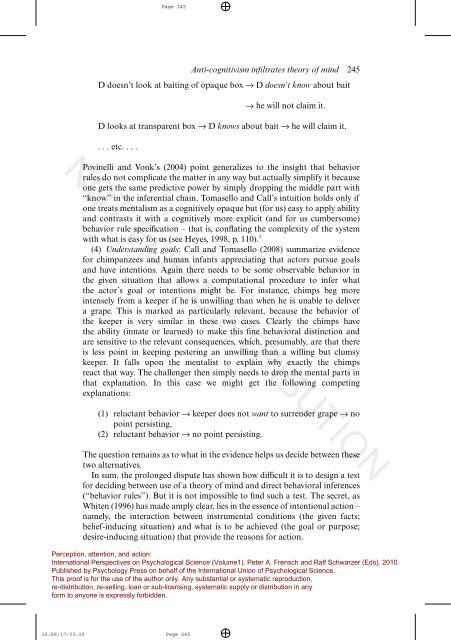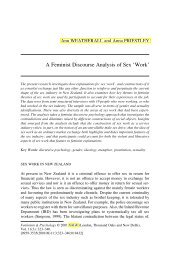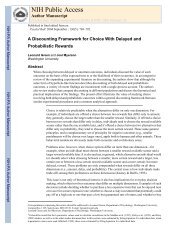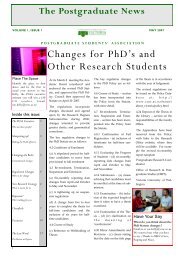Perner 2010.pdf
Perner 2010.pdf
Perner 2010.pdf
Create successful ePaper yourself
Turn your PDF publications into a flip-book with our unique Google optimized e-Paper software.
Page 245Anti-cognitivism infiltrates theory of mind 245D doesn’t look at baiting of opaque box → D doesn’t know about bait→ he will not claim it.D looks at transparent box → D knows about bait → he will claim it....etc....NOT FOR DISTRIBUTIONPovinelli and Vonk’s (2004) point generalizes to the insight that behaviorrules do not complicate the matter in any way but actually simplify it becauseone gets the same predictive power by simply dropping the middle part with“know” in the inferential chain. Tomasello and Call’s intuition holds only ifone treats mentalism as a cognitively opaque but (for us) easy to apply abilityand contrasts it with a cognitively more explicit (and for us cumbersome)behavior rule specification – that is, conflating the complexity of the systemwith what is easy for us (see Heyes, 1998, p. 110). 5(4) Understanding goals: Call and Tomasello (2008) summarize evidencefor chimpanzees and human infants appreciating that actors pursue goalsand have intentions. Again there needs to be some observable behavior inthe given situation that allows a computational procedure to infer whatthe actor’s goal or intentions might be. For instance, chimps beg moreintensely from a keeper if he is unwilling than when he is unable to delivera grape. This is marked as particularly relevant, because the behavior ofthe keeper is very similar in these two cases. Clearly the chimps havethe ability (innate or learned) to make this fine behavioral distinction andare sensitive to the relevant consequences, which, presumably, are that thereis less point in keeping pestering an unwilling than a willing but clumsykeeper. It falls upon the mentalist to explain why exactly the chimpsreact that way. The challenger then simply needs to drop the mental parts inthat explanation. In this case we might get the following competingexplanations:(1) reluctant behavior → keeper does not want to surrender grape → nopoint persisting,(2) reluctant behavior → no point persisting.The question remains as to what in the evidence helps us decide between thesetwo alternatives.In sum, the prolonged dispute has shown how difficult it is to design a testfor deciding between use of a theory of mind and direct behavioral inferences(“behavior rules”). But it is not impossible to find such a test. The secret, asWhiten (1996) has made amply clear, lies in the essence of intentional action –namely, the interaction between instrumental conditions (the given facts;belief-inducing situation) and what is to be achieved (the goal or purpose;desire-inducing situation) that provide the reasons for action.Perception, attention, and action:International Perspectives on Psychological Science (Volume1). Peter A. Frensch and Ralf Schwarzer (Eds). 2010.Published by Psychology Press on behalf of the International Union of Psychological Science.This proof is for the use of the author only. Any substantial or systematic reproduction,re-distribution, re-selling, loan or sub-licensing, systematic supply or distribution in anyform to anyone is expressly forbidden.15:58:17:03:10Page 245






